

Designation:ARR-15A, J, S Monocle
|
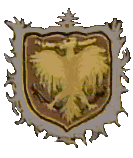
|
||||
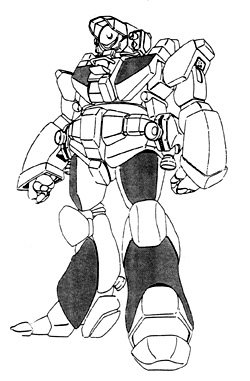
|
|||||
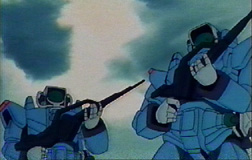
| Total Height: | 6.1 m |
| Total Depth: | 1.8 m (without Thruster pack) |
| Total Breadth: | 3.0 m |
| Weight: | 12.0 metric tons |
| 14.8 metric tons |
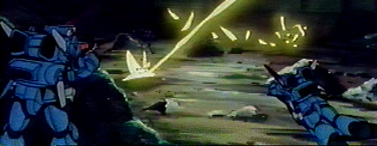
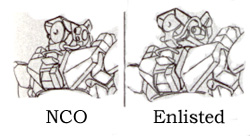
The mecha comes standard-equipped with the necessary computer enhancement and interpretation hardware, as well as with a high-speed datalink for burst transmission to headquarters.
|

|
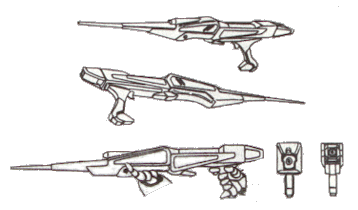
|
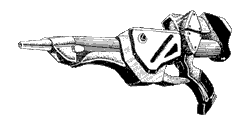
|
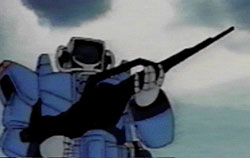
The armor on the Monocle is a new development in low-mass composite-materials Chobham plating that became the standard for all Terran mecha after its application to the VQ-6A Vandal. Aside from the respectable protection provided against projectiles, missiles, and other kinetic weapons, this armor is also resistant to plasma globes (annihilation discs), lasers, and to a lesser extent, particle guns, owing to the fact that the armor can flake off and evaporate in layers under fire from such high-energy weapons, taking much of the weapon's energy and converting it into the latent heat of sublimation in the armor. The armor stops all small arms and heavy infantry weapons fire, provides good to excellent resistance to light mecha-mounted weaponry, such as the Zentraedi 22.3mm HE autocannon round, and poor to good resistance to medium mecha-mounted weaponry, such as the Valkyrie's 55mm APFSDS round.
The Monocle provides full protection from nuclear, biological, and chemical hazards, using a fully-sealed cockpit module activated by radiation and hazardous chemical sensors, or manually when biological warfare conditions are anticipated. The cockpit module is also armored and gives the Monocle the option of operating off-planet on the moon or elsewhere in the system. The internal consumables supplies can provide atmosphere purification for one week maximum on Earth and 48 hours in a hostile environment such as the moon or Mars.
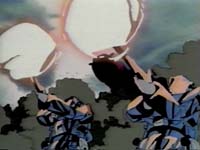
The Southern Cross Surface Command decided that the large RDF Destroids designs were too conspicuous and vulnerable to standoff missile attacks to be fully effective. Also, in urban combat, the huge robots could easily lose small vehicles in back streets that were too small to accommodate the large Destroids. As such, they desired to create smaller and more agile mecha that could better adapt to a variety of operating environments. From this desire, the SCA battloids first evolved: smaller, more agile, multi-purpose robots. It was beneficial that the smaller battloids were much cheaper to manufacture, were not dependent on internal weapons fits and did not have to be space capable.
The Southern Cross Surface Command recognized a need for a cavalry scout mecha to provide battlefield reconnaissance and forward observation to support the main forces. The Veritech hover tanks were too expensive to fill the role completely, the Destroids too big and slow and conventional IFVs such as the FIAT 6836 M-120 too vulnerable. The Bumblebee also proved too fragile for close combat observation. As such, the Monocle was designed to provide a high mobility reconnaissance and patrol battloid for the Tactical Corps Reconnaissance Divisions. These battloids also served as forward observers for the ATAC and other Tactical Corps divisions. They carried no built-in weapons as all internal space was reserved for its sensor suite and to keep the weight down to maximize speed and maneuverability. The Monocle relied on hand-carried weapons for its offensive capabilities.
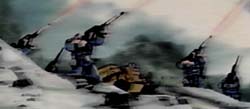
The Mk. II added the back mounted thruster and hip thrusters to provide the Monocle with flight capabilities to enhance its range and survivability. In concept, it was closest to a recon version of the Zentraedi Nousjaedul-Ger. The Mk. II could fly long distances, making it more of an effective scout than the VHT-2. Being the lightest armored of the battloids, the Monocle relied even more on speed and maneuverability rather than damage resistance for survival. Also, being lightly armed, the pilots were less likely to engage in combat when enemy contact was made. Of all of the battloids, the Monocle faired the best against the Tirolian Bioroids, its speed and maneuverability allowing it to survive where the other mecha were cut down. Regrettably, its armor was too thin to survive a defensive stand against the Bioroids, which is the scenario where most were lost, defending bases and cities from the Bioroid offensives when the other forces were destroyed or unavailable.
The Monocle's sensor suite was an extremely advanced and versatile design. The Westinghouse TPG-147 pulse-doppler radar had the longest range of any ground radar system of it's day. Rockwell's excellent AVS-10 camera system (the 'Big Eye') gave it infra-red, optical and ultra-violet vision for detecting targets in all weather, day or night. The laser range finder and designator was used to aim it's own gun pods and direct indirect fire from supporting artillery. The Norden BSP-3A packet provided such various sensors as a neural activity sensor. It could detect the unique and very weak electromagnetic activity caused by the functioning of human brains, though only at a short range and against such large targets as full sized Zentraedi.
After the war with the Robotech Masters, only a few remained to fight the Invid. Those that did make it into the Invid Occupation proved invaluable to those who actually realized what their sensors were capable of and were able to put them to good use. (i.e. away from combat.) For this reason, several good examples of the mecha exist today, and can be found in the Terran War Museum located at the site of the former Reflex Point hive.
See additional design notes.
Return to Southern Cross Mecha Index.
Go to Robotech Technical Files Home Page.
Robotech (R) is the property of Harmony Gold. This document is in no way intended to infringe upon their rights.
Content by Rob Morgenstern, Tim Wing and Pieter Thomassen, with Peter Walker